
The common quail, or European quail, is a small ground-nesting game bird in the pheasant family Phasianidae. It is mainly migratory, breeding in the western Palearctic and wintering in africa and southern India.

Typha latifolia is a perennial herbaceous plant in the genus Typha. It is found as a native plant species in North and South America, Europe, Eurasia, and Africa. In Canada, broadleaf cattail occurs in all provinces and also in the Yukon and Northwest Territories, and in the United States, it is native to all states except Hawaii. It is an introduced and invasive species, and is considered a noxious weed, in Australia and Hawaii. It has been reported in Indonesia, Malaysia, New Zealand, Papua New Guinea, and the Philippines.

The blackstart is a chat found in desert regions in North Africa, the Middle East and the Arabian Peninsula. It is resident throughout its range.
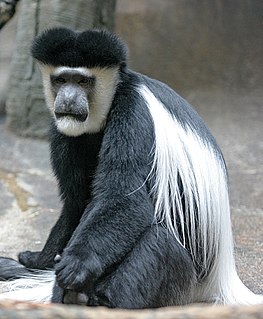
The mantled guereza, also known simply as the guereza, the eastern black-and-white colobus, or the Abyssinian black-and-white colobus, is a black-and-white colobus, a type of Old World monkey. It is native to much of west central and east Africa, including Cameroon, Equatorial Guinea, Nigeria, Ethiopia, Kenya, Tanzania, Uganda and Chad. The species consists of several subspecies that differ in appearance. It has a distinctive appearance, which is alluded to in its name; the long white fringes of hair that run along each side of its black trunk are known as a mantle. Its face is framed with white hair and it has a large white tail tuft.
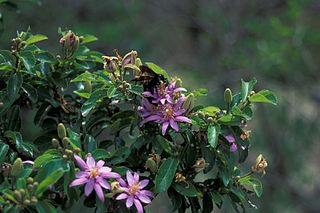
The large flowering plant genus Grewia is today placed by most authors in the mallow family Malvaceae, in the expanded sense as proposed by the Angiosperm Phylogeny Group. Formerly, Grewia was placed in either the family Tiliaceae or the Sparrmanniaceae. However, these were both not monophyletic with respect to other Malvales - as already indicated by the uncertainties surrounding placement of Grewia and similar genera - and have thus been merged into the Malvaceae. Together with the bulk of the former Sparrmanniaceae, Grewia is in the subfamily Grewioideae and therein the tribe Grewieae, of which it is the type genus.
Botta's serotine is a species of vesper bat, one of 25 in the genus Eptesicus. It can be found in Afghanistan, Azerbaijan, possibly Djibouti, Egypt, Iran, Iraq, Israel, Jordan, Kazakhstan, Kyrgyzstan, Mongolia, Oman, Pakistan, Saudi Arabia, Syrian Arab Republic, Tajikistan, Turkey, Turkmenistan, Uzbekistan, and Yemen. It is found in rocky areas and temperate desert.

Lichtenstein's sandgrouse is a species of bird in the Pteroclidae family, which is named after Martin Lichtenstein. They are nomadic, mostly nocturnal birds, which drink before dawn and after dusk.

Grewia occidentalis, the crossberry, is a small, hardy, attractive tree indigenous to Southern Africa.
Phyllonorycter grewiella is a moth of the family Gracillariidae. It is known from South Africa, Botswana, Kenya, Namibia and coastal Yemen. The habitat consists of the coastal savannahs of southern and East Africa and the forests belonging to the Zanzibar-Inhambane floristic region.
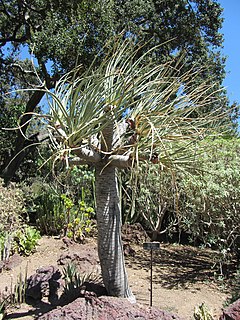
Dracaena serrulata also called the Arabian or Yemen Dragon Tree is a distinctive tree reaching around 5m tall with a single trunk. It is found in the dry escarpment mountains of southwestern Arabia from Oman, South Yemen and Saudi Arabia.

Protea glabra, also called the Clanwilliam sugarbush, is a flowering shrub belonging to the genus Protea.

Protea grandiceps, commonly known as rooisuikerbos, suikerbos or red sugarbush, is a flowering shrub that belongs to the Protea genus and is native to parts south western parts of South Africa. The shrub was listed as an+ near threatened species in 2006 according to the South African National Biodiversity Institute.

Sideroxylon mascatense is a species of flowering plant in the family Sapotaceae.
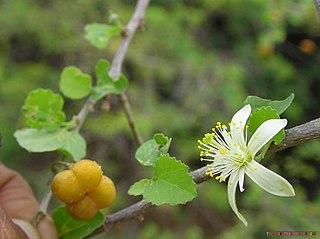
Grewia tenax, called the phalsa cherry, white crossberry, raisin bush, gangara, gangu, or kanger, is a species of flowering plant in the family Malvaceae. It is native to Africa, from the Sahara to Tanzania and parts of southern Africa, the Arabian Peninsula, and on to the Indian Subcontinent. The ripe fruit is edible and is consumed by local peoples either fresh, dried, or powered in drinks.
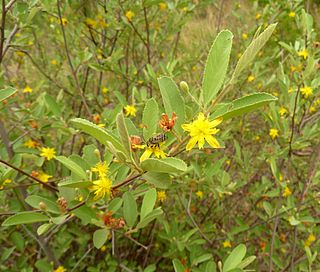
Grewia flava, the brandy bush, wild currant, velvet raisin, or raisin tree, is a species of flowering plant in the family Malvaceae, native to southern Africa. A common shrub species, it is spreading into grasslands due to human rangeland management practices, and increasing rainfall. The berries are sweet and edible, but have little flesh and so are typically collected to ferment into alcoholic beverages. The desert truffle Kalaharituber pfeilii is often found in association with its roots.

Grewia flavescens, called rough-leaved raisin, sandpaper raisin, and donkey berry, is a species of flowering plant in the family Malvaceae, native to sub‑Saharan Africa, Yemen, Saudi Arabia, and India. It is considered to be an underutilized crop, both for its fruit and its use for livestock forage.

Grewia hexamita, the giant raisin, is a species of flowering plant in the family Malvaceae, native to Mozambique and adjoining countries. It is a large tree for a Grewia, reaching 5 m (16 ft). It is the most preferred woody plant of African savanna elephants, who browse on it in all seasons, unlike even other species of Grewia.
Grewia mollis is a widespread species of flowering plant in the family Malvaceae, native to tropical Africa, Yemen and Oman. It is the source of grewia gum, an edible polysaccharide mucilage, similar in its properties to tragacanth gum.















